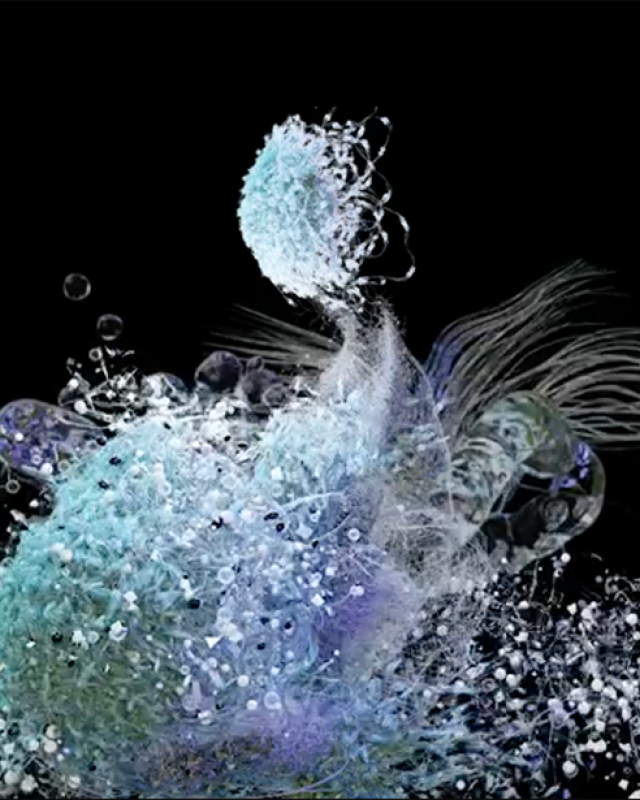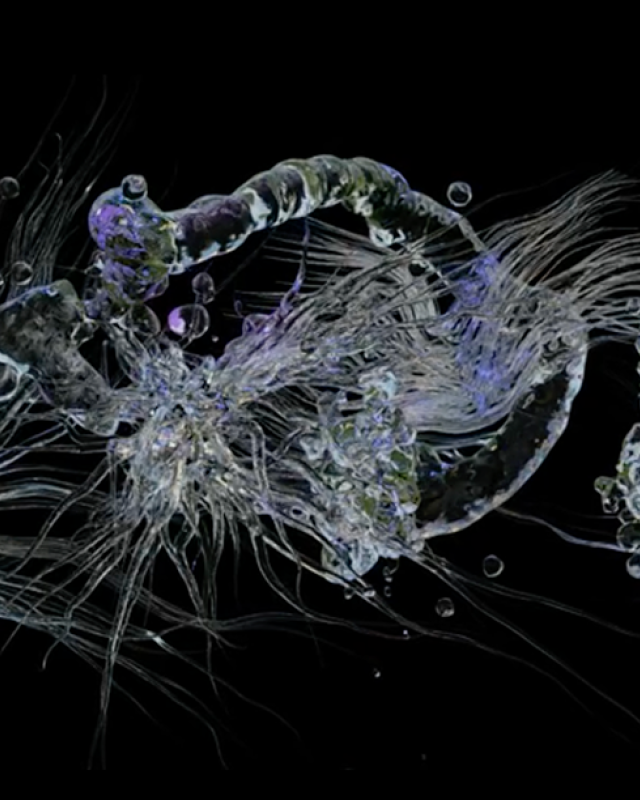Digital Wall Exhibition: Kai-Hai: 塑 Plastia
July - November 2025
Bunjil Place Foyer
The Digital Wall in the Bunjil Place foyer is a digital gallery space that exhibits video art and generative works. We are thrilled to present the mesmerising digital artwork Kai-Hai: 塑 Plastia by international artists Tiare Ribeaux and Qianqian (Q) Ye.
Kai-Hai: 塑 Plastia
Digital artwork by Tiare Ribeaux and Qianqian (Q) Ye
Kai-Hai: 塑 Plastia is a video work that explores The Great Pacific Garbage Patch - a great gyre of microplastics and other marine debris over nearly a 2 million-square-kilometre region of ocean linking East Asia to Hawai‘i. Linking these geographies and the deities they have worshipped - from Mazu, goddess of seafarers lost in the ocean; to Haumea, who birthed the Hawaiian islands and is continuously reborn in her offspring - this new work in Kai 海 Hai speculates the emergence of a Goddexx formed from the microplastics from the ocean. She continually gives birth to new children and is reborn each time within them. As plastics threaten our ocean health and all species in the ocean, Plastia is a response to the forces of creation and destruction, the worship of convenience and capitalism that can become monstrosities, and the need to cleanse our ancestral waters. In the Kumulipo, a pre-Darwinian Hawaiian creation story, all creatures are spawned from the ocean in a lineage that connects to us as Kānaka/humans on land. This Goddexx hails a return to the waters, remembering our older gods and guardians, and envisioning a new lineage to remediate and cleanse our oceans.
Kai 海 Hai (a hybrid of ‘Ocean’ in ʻŌlelo Hawai'i and Mandarin) is a collaboration between Kānaka Maoli artist Tiare Ribeaux and Chinese artist and technologist Qianqian Ye. It is an ongoing series of immersive 3D installations utilizing transpacific folklore, oral histories, and mythologies from Polynesia to East Asia - to explore environmental issues, indigenous and immigrant stories, ancestral/ personal/speculative narratives, and diaspora across the Pacific Ocean.
Tiare Ribeaux
Tiare Ribeaux is a Kanaka Maoli filmmaker, artist and creative producer based in Honolulu, Hawai‘i. Her work takes a decolonial approach to storytelling by employing non-linear narratives akin to our elemental cycles to tell stories around transformation and healing, centering how our bodies are inextricably linked to land and water systems. She integrates magical realism into her films, letting a story unfold across multiple characters and elemental forces, and using components of speculative fiction and fantasy to reimagine both our present realities and future trajectories of land reclamation, restoration, queerness, and belonging. Outside of film festivals, she has shown her work at galleries and museums in multi-channel, immersive installations, and live cinematic performances.
She has shown work both nationally and internationally, and has won numerous grants and awards for her artistic leadership including the Creative Capital Award, the NDN Radical Imagination Grant, the Native Lab Fellowship and Indigenous Film Fund from Sundance, two New and Experimental Works Grants from the Kenneth Rainin Foundation, the Building Demand for the Arts Grant from the Doris Duke Foundation, among others. She has given talks at conferences and universities including a keynote at ISEA 2024 Brisbane, and guest lectures at Stanford, MIT, UC Berkeley, UH Manoa, RPI, and others. She served as Artistic Director at B4BEL4B Gallery for 8 years, curated and produced various media arts and performance festivals including the Soundwave Biennial and the Codame Festival, and taught international media arts workshops in Kyiv, Ukraine (2018) as part of the American Arts Incubator and Ōtepoti, Aotearoa (2023) as part of Leonardo’s Cultural Impact Lab.
Qianqian (Q) Ye
Qianqian (Q) Ye (she/they) is a Chinese artist, creative technologist and educator based in Los Angeles (Gabrielino-Tongva Land). Trained as an architect, she creates digital, physical, and social spaces exploring issues around gender, immigrant, power, and technology. Their most recent collaborative project, The Future of Memory, was a recipient of the Mozilla Creative Media Award. At the Processing Foundation, Qianqian is the Lead of p5.js, an open-source art and education platform that prioritizes access and diversity in learning to code, with over 1.5 million users. She currently teaches creative coding as an Adjunct Assistant Professor at USC Media Arts + Practice and 3D Arts at Parsons School of Design. For 2022-2023, Qianqian is a Civic Media Fellow at USC Annenberg Innovation Lab.
Qianqian was born and raised in China and moved to the US in 2012. Her current practice focuses on alternative community building, technology against misinformation, the Chinese language system, and re-imagining gender in a non-western narrative. She holds a Master of Landscape Architecture from Cornell University and a Bachelor of Architecture from ZJUT. Her works have been shown at Museum of Contemporary Canadian Art, Ecobuild London, Killscreen Magazine and various exhibitions in US and China. She worked at a number of design practices internationally, from the US (NIO, Gehl Studio), Denmark (BIG, SHL), to China (Vector Architects).


